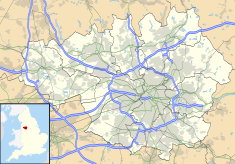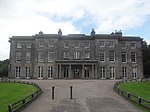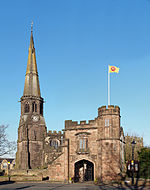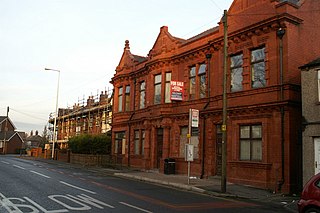
Abram is a village and electoral ward in the Metropolitan Borough of Wigan, Greater Manchester, England. It lies on flat land on the northeast bank of the Leeds and Liverpool Canal, 2 miles (3.2 km) west of Leigh, 3 miles (4.8 km) southeast of Wigan, and 14.5 miles (23 km) west of Manchester. Abram is a dormitory village with a population of 9,855.

Ince-in-Makerfield or Ince is a town in the Metropolitan Borough of Wigan, in Greater Manchester, England. The population of the Ince ward at the 2011 census was 13,486, but a southern part of Ince was also listed under the Abram ward. Adding on this area brings the total in 2011 to 15,664.

The Elephant Tea Rooms is a Grade II listed building in Sunderland, Tyne and Wear, England. The building was constructed from 1872 to 1877 by Henry Hopper to a design by architect Frank Caws for William Grimshaw, a local tea merchant and grocer, in a blend of the high Victorian Hindu Gothic and Venetian Gothic styles. This was a selling point, as the exotic style and name advertised the exotic origins of the tea sold there. The building has housed the Local History Library of the city since 2020.
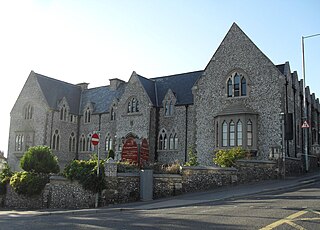
Citibase Brighton is a complex of serviced offices on a prominent elevated position in the Round Hill area of Brighton, part of the English city of Brighton and Hove. The large Gothic Revival building, by two architect brothers from London, has had three greatly different uses since its construction at the edge of Brighton parish in 1854: for its first 85 years, it trained Anglican schoolmistresses; then it became a military base and records office; and in 1988 it opened as a multipurpose business centre and office complex. The elaborate flint exterior is finely detailed in the Gothic style, especially around the windows. English Heritage has listed it at Grade II for its architectural and historical importance.

Leigh Town Hall is a municipal building in Leigh, Greater Manchester, England. It stands in Civic Square at the junction with Market Street, facing Leigh parish church. It was built in 1907 and granted grade II listed building status in 1987.
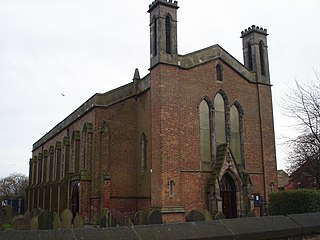
St John the Divine's Church is in Church Street, Lamberhead Green, Pemberton, Wigan, Greater Manchester, England. It is an active Anglican parish church in the deanery of Wigan, the archdeaconry of Warrington, and the diocese of Liverpool. The church is recorded in the National Heritage List for England as a designated Grade II listed building. It was a Commissioners' church, having received a grant towards its construction from the Church Building Commission.
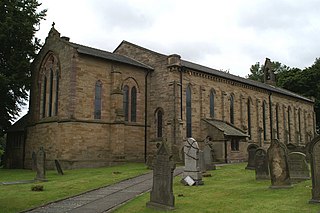
St David's Church is in Copperas Lane, Haigh, Wigan, Greater Manchester, England. It is an active Anglican parish church in the deanery of Wigan, the archdeaconry of Warrington, and the diocese of Liverpool. The church is recorded in the National Heritage List for England as a designated Grade II listed building. It was a Commissioners' church, having received a grant towards its construction from the Church Building Commission.
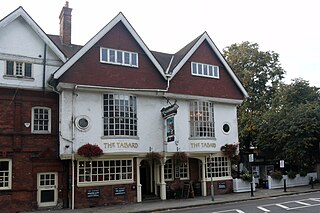
The block of three buildings containing The Tabard public house is a Grade II* listed structure in Chiswick, London. The block, with a row of seven gables in its roof, was designed by Norman Shaw in 1880 as part of the community focus of the Bedford Park garden suburb. The block contains the Bedford Park Stores, once a co-operative, and a house for the manager.
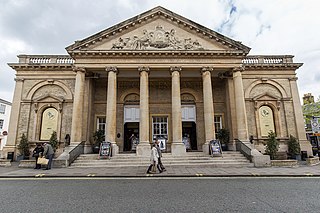
Corn exchanges are distinct buildings which were originally created as a venue for corn merchants to meet and arrange pricing with farmers for the sale of wheat, barley, and other corn crops. The word "corn" in British English denotes all cereal grains, such as wheat and barley. With the repeal of the Corn Laws in 1846, a large number of corn exchanges were built in England, particularly in the corn-growing areas of Eastern England.

Rutherglen Town Hall is a municipal facility on the north side of Main Street in Rutherglen, Scotland. The town hall, which was the headquarters of Rutherglen Burgh Council, is a Category A listed building.
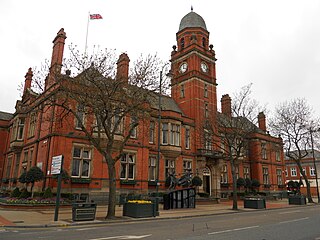
Hyde Town Hall is a municipal building in the Market Street, Hyde, Greater Manchester, England. The town hall, which was the headquarters of Hyde Borough Council, is a grade II listed building.

Dukinfield Town Hall is a municipal building in King Street, Dukinfield, Greater Manchester, England. The town hall, which was the headquarters of Dukinfield Borough Council, is a grade II listed building.

Westhoughton Town Hall is a municipal building in Market Street, Westhoughton, Greater Manchester, England. The town hall is the meeting place of Westhoughton Town Council.

The Borough Hall is a municipal building in Eastgate Street, Stafford, Staffordshire, England. The borough hall, which formed the headquarters of Stafford Borough Council, is a Grade II listed building.

The Municipal Buildings are based in Corn Exchange Road, Stirling, Scotland. The structure, which was the meeting place of Stirling Burgh Council, is a Category B listed building.

Denny Town House is a municipal building in Glasgow Road, Denny, Falkirk, Scotland. The structure is used by Falkirk Council for the provision of local services.

Dingwall Sheriff Court is a former judicial structure in the High Street, Dingwall, Highland, Scotland. The complex, which was used as the headquarters of Ross and Cromarty County Council as well as the local courthouse before being converted for residential use in 2015, is a Category B listed building.

Hindley Town Hall, also known as Hindley Council Offices, is a municipal building in Cross Street, Hindley, Greater Manchester, England. The building is currently used by Wigan Metropolitan Borough Council for the delivery of local health and social care services.
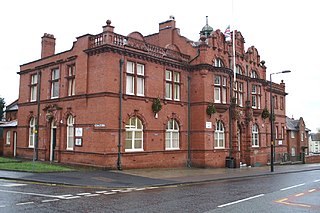
Ince-in-Makerfield Town Hall, also known as Ince-in-Makerfield Council Offices, is a municipal building in Ince Green Lane, Ince-in-Makerfield, Greater Manchester, England. The building is currently used as a children's nursery.

Carlow Town Hall is a municipal building in Centaur Street, Carlow, County Carlow, Ireland. The building accommodated the offices of Carlow Town Council until 2014 but is now used as a community events venue.

